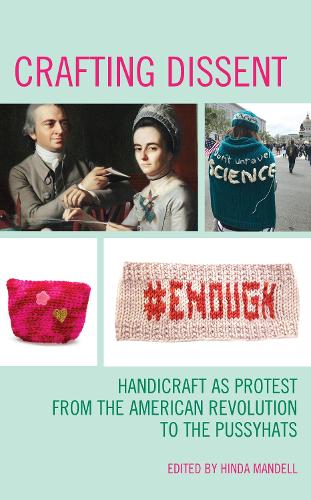
Crafting Dissent: Handicraft as Protest from the American Revolution to the Pussyhats
(Paperback)
Publishing Details
Crafting Dissent: Handicraft as Protest from the American Revolution to the Pussyhats
By (Author) Hinda Mandell
Bloomsbury Publishing PLC
Rowman & Littlefield Publishers
28th April 2021
United States
Classifications
General
Non Fiction
Museology and heritage studies
Handicrafts, decorative arts and crafts
305.42
Physical Properties
Paperback
360
Width 155mm, Height 229mm, Spine 20mm
481g
Description
Pussyhats, typically crafted with yarn, quite literally created a sea of pink the day after Donald J. Trump became the 45th president of the United States in January 2017, as the inaugural Womens March unfolded throughout the U.S., and sister cities globally.
But there was nothing new about women crafting as a means of dissent.
Crafting Dissent: Handicraft as Protest from the American Revolution to the Pussyhats is the first book that demonstrates how craft, typically involving the manipulation of yarn, thread and fabric, has also been used as a subversive tool throughout history and up to the present day, to push back against government policy and social norms that crafters perceive to be harmful to them, their bodies, their families, their ideals relating to equality and human rights, and their aspirations. At the heart of the book is an exploration for how craft is used by makers to engage with the rhetoric and policy shaping their countrys public sphere.
The book is divided into three sections: "Crafting Histories," Politics of Craft," and "Crafting Cultural Conversations."
Three features make this a unique contribution to the field of craft activism and history:
The inclusion of diverse contributors from a global perspective (including from England, Ireland, India, New Zealand, Australia)Essay formats including photo essays, personal essays and scholarly investigationsThe variety of professional backgrounds among the books contributors, including academics, museum curators, art therapists, small business owners, provocateurs, artists and makers.This book explains that while handicraft and craft-motivated activism may appear to be all the rage and of the moment, a long thread reveals its roots as far back as the founding of American Democracy, and at key turning points throughout the history of nations throughout the world.
Reviews
For historians, the blend of the diverse essays is helpful in that it encourages linking past (and the history of crafts used for resistance and activism) to present (successful models of craft for political and economic engagement). This type of connection can only deepen our understanding of the history of craft for activism (or craftivism), and our representation of it in our museum collections and writing. For readers interested in engaging in craft for dissent, the lessons of activist crafting, both in the distant and more recent past, are valuable in making decisions about how to carry out craft-based actions. * New York History *
Hinda Mandells comprehensive anthology arrives three years after the 2016 U.S. Presidential election and the advent of craftivisms third wave, a ripe time for an in-depth examination of political craft. The talented authors cover a lot of ground from early Roman resistance to the Pussyhats of today and much like the fields communal ethos, their combined efforts result in a collective potency. Together, the contributors illuminate the many ways in which craft offers agency, cultivates resiliency, and strengthens our social fabric. As a museum curator and engaged citizen, I will be keeping this volume close at hand. -- Beth C. McLaughlin, chief curator of exhibitions and collections, Fuller Craft Museum
Refreshingly, the contributors in this volume do not present a tidy, celebratory, step-by-step guide to handmade activism, instead they address the many contingencies of both craftivist discourse and action as they engage with issues of race, class, gender, and power. They show that handwork wielded by engaged citizens has the power to reshape the stories we build our cultures around while simultaneously requiring similarly critical transformation itself. -- Sonja Dahl, artist, writer, activist
In a word, empowering. After reading Crafting Dissent: Handicraft as Protest from the American Revolution to Pussyhats I had to spend time reflecting with my needle and thread. This collection of thoughtful essays empowers through its stories of handicraft as it is tied to social justice. Women have had a voice for centuries, but sometimes it has had to be vocalized through their crafty creations. -- Sarah Marsom, heritage resource consultant
[C]ontemporary craft scholars, makers, and the general public alike will find this to be a useful book with which to begin seeing dissent as a through line across different temporalities. In particular, communications scholars will find this volume to be a rich resource as this perspective permeates the book both through the editor and many of the authors. Nevertheless, authors from a variety of backgrounds each bring their expertise to bear without using discipline-specific language, which sets an accessible tone. The relatively short chapters and the use of full-color images adds to this approachability. * H-Net: Humanities and Social Science Reviews Online *
Author Bio
Hinda Mandell is associate professor in the School of Communication at RIT in New York, and is editor of Crafting Dissent: Handicraft as Protest from the American Revolution to the Pussyhats (Rowman & Littlefield, 2019); co-curator and co-editor of Crafting Democracy: Fiber Arts and Activism (RIT Press, 2019); a co-editor of Nasty Women and Bad Hombres: Gender and Race in the 2016 US Presidential Election (University of Rochester Press, 2018); the author of Sex Scandals, Gender and Power in Contemporary American Politics (Praeger, 2017) and co-editor of Scandal in a Digital Age (Palgrave Macmillan, 2016). Mandells website is omghinda.com, and shes on Twitter: @hindamandell and @crochetactivism, and Instagram: @crochetactivism. Mandell is passionate about organizing crowd-created yarn installations in public spaces that are connected to the history of a region's social-reform movements.
